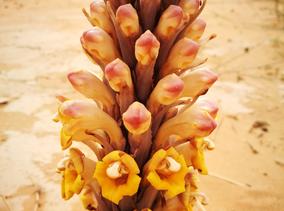You are here
Saudi Arabia flora checklist
Orobanchaceae
Nomencalture
SUMMARY
Orobanchaceae
Achlorophyllous herbs. More or less ‘normal’ plants. Leaves much reduced. Plants more or less succulent; more or less totally parasitic. On roots of the host. Leaves small; alternate; spiral; membranous; sessile; non-sheathing; simple. Lamina entire; lanceolate, or oblong to ovate. Leaves exstipulate. Lamina margins entire. Flowers aggregated in ‘inflorescences’; in racemes and in spikes. The terminal inflorescence unitracemose. Inflorescences terminal; usually spikes, rarely racemes. Flowers bracteate (one flower in the axil of each scale); small to medium-sized; very irregular. Flowers tetracyclic. Hypogynous disk present (fleshy). Perianth with distinct calyx and corolla; (6–)8, or 10; 2 whorled; isomerous (usually), or anisomerous. Calyx 4–5 (fid), or 2 (the four sepals sometimes more or less united into a lateral pair); 1 whorled; gamosepalous; blunt-lobed, or toothed (or variously split); unequal but not bilabiate, or bilabiate; persistent; valvate, or open in bud. Corolla 5; 1 whorled; gamopetalous (the tube often curved); imbricate (the adaxial members internal); unequal but not bilabiate to bilabiate; persistent. Androecium 4, or 5.Androecial members adnate (epipetalous); markedly unequal; free of one another; 1 whorled. Androecium exclusively of fertile stamens, or including staminodes. Staminodes when present, 1; in the same series as the fertile stamens; representing the posterior median member. Fertile stamens representing the posterior-lateral pair and the anterior-lateral pair. Stamens 4; inserted near the base of the corolla tube, or midway down the corolla tube (below the middle); didynamous; reduced in number relative to the adjacent perianth (the posterior androecial member being absent or staminodal); oppositisepalous; alternating with the corolla members. Anthers cohering, or separate from one another; dorsifixed; dehiscing via longitudinal slits; introrse; unilocular to bilocular; tetrasporangiate; appendaged (the connective sometimes spurred at the top), or unappendaged. Pollen grains aperturate, or nonaperturate (occasionally); 3 aperturate; colpate, or colporate (or colporoidate, or ‘more or less irregular’); 2-celled. Gynoecium 2 carpelled (usually), or 3 carpelled. Carpels reduced in number relative to the perianth. The pistil1 celled. Gynoecium syncarpous; synstylovarious, or eu-syncarpous; superior. Ovary 1 locular. Gynoecium usually median. The ‘odd’ carpel (when G3) posterior. Gynoecium stylate. Styles 1; attenuate from the ovary; apical. Stigmas 2–4 lobed; dry type; papillate. Placentation parietal (the placentas sometimes branched). Ovules in the single cavity 12–100 (‘many’); non-arillate. Embryo-sac development Polygonum-type. Fruit non-fleshy; dehiscent; a capsule.Capsules loculicidal, or valvular. Fruit 12–100 seeded (‘many’). Seeds endospermic. Endosperm oily.Seeds minute. Seeds with starch. Embryo rudimentary at the time of seed release. Embryo achlorophyllous (1/1).


